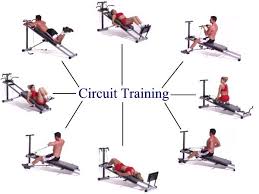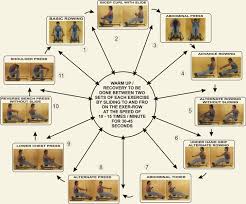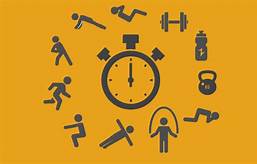|
 click on the Item click on the Item
 Interval Training Interval Training
 
Interval training is a high intensity workout followed by a rest interval during which activity of moderate to low intensity is carried out. This type of endurance training is very good for improving aerobic capacity, which is a must for sports such as Kabaddi which demand explosive strength and endurance. Kabaddi is a sport which is patterned on the Interval style, i.e., one raid of high intensity for 30 seconds followed by moderate activity by the raider when he assumes his defence position in his home court before his next forage into the opponents’ court again of high intensity. The sport itself is patterned on the style of Interval training since the raider goes for high intensive activity during his raid lasting about 30 seconds while his counterparts have a recovery interval until he returns to home court. Interval training is a fitness training method which is used in other forms of training such as circuit training and weight training with a number of repetitions which is considered very good for improving aerobic capacity of the sports persons.

The coach should carefully design the interval training programme keeping in view the age, potential and experience of the Kabaddi player. Keeping these factors in view, the intensity or load of the work out, its duration and number of repetitions can be worked out. The repetitions can be gradually increased and the rest pauses of moderate to low intensity can be decreased, depending upon the standard and fitness of the players.

The best guide for deciding upon the intensity of the work out and the duration of the rest pause of moderate to low intensity work out in between is the heart rate of the individual. For players under the age of 30 years the recommended heart rate at the end of the work out is 180 beats per minute. Counting the pulse for 10 seconds and multiplying the figure by six determines the heart rate. The relief pause is not to be of too long duration for this will reduce the aerobic effects of the training. The recommended heart rate at the end of the rest interval is 150 beats per minute.
 Circuit Training Circuit Training
 
WHAT IS CICUIT TRAINING???

Circuit training is a fast-paced activity in which you do one exercise for 30 seconds to 2 minutes and then move on to another exercise. It’s like a game of musical chairs: Everyone begins at one station from a place where an exercise is done, and when the instructor signals, everyone moves to the next station.for the next excercise.
Circuit training is an excellent means to improve endurance, speed and strength. Circuit training involves six to twelve exercise stations with exercises for various muscle groups of the abdomen, back, legs, and arms arranged in a circle. Circuit training is based on the principle of easy to severe, simple to complicated and general to specific exercises. In addition to endurance, speed and strength, circuit training can also help develop resistance power with the help of a partner.

The fundamental skills of Kabaddi can be effectively taught with the help of circuit training. Various methods such as the continuous method, interval method, repetition method and resistance training method can be adopted for Circuit training keeping in view the age & potential of the sports person as well as the aim of the training programme.
  
 weight Training weight Training
  Kabaddi demands explosive power combined with speed & strength to overcome the opponent in this body contact combative sport. The players is said to be in good form when he is able to use explosive power effectively combined with skill. Weight training exercises can develop the explosive power along with strength and flexibility. A fit body is a combination of strength, suppleness and stamina. Weight training can bring out the hidden potential of the body to an extent far beyond normal capacity. Kabaddi demands explosive power combined with speed & strength to overcome the opponent in this body contact combative sport. The players is said to be in good form when he is able to use explosive power effectively combined with skill. Weight training exercises can develop the explosive power along with strength and flexibility. A fit body is a combination of strength, suppleness and stamina. Weight training can bring out the hidden potential of the body to an extent far beyond normal capacity.
The greatest advantage of weight training is that it exercises specific muscle groups to bring out their explosive strength. For instance, a raider who uses his leg muscles in footwork & leg thrusts during the raid can use weigh training to improve the explosive strength of his calf and leg muscles. Weight training not only increases fitness, but builds resistance to injuries.
 This training is also beneficial for injured sportspersons, who can use the right type of weight training exercises under expert guidance to recover from the injury, since weakened injured muscles can be strengthened to their former state with the help of weight training exercises. There are various means of weight training such as multi-gyms with different exercise stations, weight training with free weights such as medicine balls, sand bags, dumb bells, bar bells of different poundage etc. The sportsperson should start with light weights and gradually increase the poundage. When the exercise gets easier, he should increase the poundage gradually to get the best results. This training is also beneficial for injured sportspersons, who can use the right type of weight training exercises under expert guidance to recover from the injury, since weakened injured muscles can be strengthened to their former state with the help of weight training exercises. There are various means of weight training such as multi-gyms with different exercise stations, weight training with free weights such as medicine balls, sand bags, dumb bells, bar bells of different poundage etc. The sportsperson should start with light weights and gradually increase the poundage. When the exercise gets easier, he should increase the poundage gradually to get the best results.
 The basic principles of weight training are essentially identical to those of strength training, and involve a manipulation of the number of repetitions (reps), sets, tempo, exercise types, and weight moved to cause desired increases in strength, endurance, and size. The specific combinations of reps, sets, exercises, and weights depends on the aims of the individual performing the exercise. Sets with fewer reps can be performed with heavier weights, as well as sets with higher reps with lighter weights. The basic principles of weight training are essentially identical to those of strength training, and involve a manipulation of the number of repetitions (reps), sets, tempo, exercise types, and weight moved to cause desired increases in strength, endurance, and size. The specific combinations of reps, sets, exercises, and weights depends on the aims of the individual performing the exercise. Sets with fewer reps can be performed with heavier weights, as well as sets with higher reps with lighter weights.
 In addition to the basic principles of strength training, a further consideration added by weight training is the equipment used. Types of equipment include barbells, dumbbells, pulleys and stacks in the form of weight machines, and the body's own weight in the case of chin-ups and push-ups. Different types of weights will give different types of resistance, and often the same absolute weight can have different relative weights depending on the type of equipment used. For example, lifting 10 kilograms using a dumbbell sometimes requires more force than moving 10 kilograms on a weight stack if certain pulley arrangements are used. In other cases, the weight stack may require more force than the equivalent dumbbell weight due to additional torque or resistance in the machine. Additionally, although they may display the same weight stack, different machines may be heavier or lighter depending on the number of pulleys and their arrangements. In addition to the basic principles of strength training, a further consideration added by weight training is the equipment used. Types of equipment include barbells, dumbbells, pulleys and stacks in the form of weight machines, and the body's own weight in the case of chin-ups and push-ups. Different types of weights will give different types of resistance, and often the same absolute weight can have different relative weights depending on the type of equipment used. For example, lifting 10 kilograms using a dumbbell sometimes requires more force than moving 10 kilograms on a weight stack if certain pulley arrangements are used. In other cases, the weight stack may require more force than the equivalent dumbbell weight due to additional torque or resistance in the machine. Additionally, although they may display the same weight stack, different machines may be heavier or lighter depending on the number of pulleys and their arrangements.
 Resistance Training Resistance Training

RESISTANCE TRAINING
A significant feature of Kabaddi which is a body contact combative sport is that one player has to resist the joint efforts of his opponent team which could comprise of seven or lesser number of players during his raid. Resistance training for Kabaddi players will prepare them to face such situations.
Resistance Training is of prime importance since it increases muscle strength by making the muscles work against a weight or force. Different forms of resistance training include using free weights, weight machines, resistance bands and own or a partner body weight.
What Is Resistance Training?
Resistance training is any exercise that causes the muscles to contract against an external resistance in order to increase strength, tone, mass, and endurance. The greater the resistance or weight, greater is the muscular effort. The external resistance can be dumbbells, rubber or partner exercises, your own body weight, bricks, bottles of water, or any other object that causes the muscles to contract.
Progressive increase of intensity in training will result in getting maximum gain from resistance training according to experience and training goals.

Benefits of resistance training
|
1. improved muscle strength and tone –
to protect joints from injury
2. maintaining flexibility and balance
3. greater stamina
4. improved mobility and balance
5. decreased risk of injury
6. boosts self-confidence, improves body image
and uplifts mood enhanced performance
|
Different types of resistance training include:
-
Free weights – By using strength training tools such as dumbbells, barbells and kettlebells
-
Medicine balls or sand bags – By using weighted balls or bags
-
Weight machines – devices that have adjustable seats with handles attached either to weights or hydraulics
-
Resistance bands – like giant rubber bands – these provide resistance when stretched. They are portable and can be adapted to most workouts. The bands provide continuous resistance throughout a movement
-
Partner Exercises – Since Kabaddi is a body contact sport, partner resistance exercises are very beneficial
-
Multi-Gym with different exercise stations
-
Running against strong wind
-
Running or playing in shallow water
 Cross Country Cross Country
CROSS COUNTRY RUNNING

Cross country running is a sport in which teams and individuals run a race on open-air courses over natural terrain. SEndurance is one of the fundamental requirements for a Kabaddi player. Endurance can be developed with fitness training such as cross country runs, fartlek, interval training, circuit training etc. Cross country running helps in improving muscular endurance of the sports person. This is an endurance training designed to develop a reservoir of stamina and self control in the sportsperson while making his training enjoyable.
 In endurance training it is essential to make gradual increments in the amount of load and in the intensity. The cross country training should commence with slow easy runs over courses of 03 kms with gradual increase in the distance and the toughness of the terrain chosen for the cross country run. In endurance training it is essential to make gradual increments in the amount of load and in the intensity. The cross country training should commence with slow easy runs over courses of 03 kms with gradual increase in the distance and the toughness of the terrain chosen for the cross country run.
Cross country running involves very little specialized equipment. Most races are run in shorts and vests or singlets, usually in club or school colours. In particularly cold conditions, long-sleeved shirts and tights can be worn to retain warmth without losing mobility. The most common footwear are cross country spikes or lightweight racing shoes with a rubber sole.


 Fartlek Fartlek

Fartlek, which means "speed play" in Swedish, is a training method that blends continuous training with interval training. Fartlek runs are a very simple form of a long distance run. Fartlek training “is simply defined as periods of fast running intermixed with periods of slower running."
Fartlek is an endurance training with a difference. This type of endurance training does not call for a pre-drawn schedule or the close supervision of the coach/sports trainer.

Fartlek indicates speed play and is akin to the physical activity engaged in by children who use their energy to the fullest extent – play hard, rest a while and resume play after a brief pause with renewed vigour. This type of endurance training is best performed in natural surroundings, alongside a river, on the sea shore, in a wooded area, on hilly terrain etc.

The sportsperson is left to his or her own devises to undertake this kind of endurance training which also helps develop self reliance. Fartlek makes the exercise seem like play and the lack of any pre-drawn schedules/restrictions gives the sports person scope to improvise, set his own pace to make the exercise physically challenging and mentally invigorating. This type of training can also be effectively used in the development of specific skills in the form of skill drills.
Fartlek running involves varying your pace throughout your run, alternating between fast segments and slow jogs. Unlike traditional interval training that involves specific timed or measured segments, fartleks are more unstructured. Work-rest intervals can be based on how the body feels.With fartlek training, you can experiment with pace and endurance, and to experience changes of pace. Many runners, especially beginners, enjoy fartlek training because it involves speed work. But it is more flexible and not as demanding as traditional interval training. Another benefit of fartlek training is that it doesn't have to be done on a track and can be done on all types of terrains -- roads, trails, or even hills.
Here's what a sample fartlek workout would look like: 
-
10 minute warm-up
-
1 minute on (fast pace),
-
2 minutes off (easy),
-
2 minutes on,
-
1 minute off
-
Repeat fartlek set 3-4 times
-
10 minute cool down
-
|
|